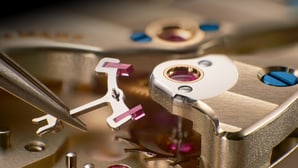The fusée-and-chain transmission is one of the most effective complications when it comes to increasing the rate accuracy of a mechanical watch.
The fusee-and-chain transmission
Harnessing the laws of physics
It is one of the tenets of physics that the power generated by the mainspring is high when it is fully tensioned and significantly weaker as it nears the fully unwound state. This can cause rate accuracy fluctuations. The fusée-and-chain transmission works like an infinitely variable gearbox. It equalises the waning force of the mainspring and makes sure that the movement always receives a constant amount of energy. This keeps the watch running at an exact rate.
Visible power transmission
Large openings in the three-quarter plate make it possible to observe the interaction of the numerous individual parts through the sapphire-crystal caseback. When the watch is fully wound, the chain is completely wrapped around the fusée. As the spring relaxes, the entire barrel rotates and winds up the chain. In doing so, it turns the fusée, which transfers the torque to the going train via a drive wheel.
Force equalisation according to the principle of levers
The fusée-and-chain transmission obeys the principle of levers. The fusée is shaped like a cone with a helical groove cut into its lateral surface. With full power, the mainspring barrel tugs at the top of the cone, i.e. at the shorter lever. As the spring loses energy, the chain reels off toward the broader end of the cone: as the radius grows, the lever becomes longer.
A drive with a forward and reverse gear
To guarantee that the watch continues to run even while it is being wound, the fusée accommodates a tiny planetary gear system. It assures that power transmission is not interrupted during the winding process, even though the fusée then rotates against the unwind direction.
The perfect middle
When the mainspring is fully wound, and briefly before the fully unwound state, the fusée-and-chain mechanism reaches its limits. This is because in both cases, the torque delivered by the mainspring fluctuates suddenly and incalculably. To assure the utmost in precision, the power-reserve period is thus limited to the middle torque delivery range, where the energy output declines uniformly and calculably.
Blockage before fully wound state
A blocking mechanism becomes active to bypass the sudden loss of force in the fully wound state. It prevents the mainspring from being fully wound: a rivet (1) in the chain activates a lever system (2) at whose end an arresting tooth (3) pushes into the ratchet wheel (4). This blocks the fusée (5), which is rigidly connected to the ratchet wheel.
Blockage before fully unwound state
A second mechanism prevents the occurrence of the second sudden force-loss range. It stops the movement before the mainspring is fully unwound: the power-reserve wheel (6) is the crucial element here. During the 36-hour power reserve period, it rotates by about 300 degrees.
At the end of this path, the beak of a lever (7) drops into the recess in the power-reserve wheel. Simultaneously, its other end (8) pivots into the range of the blocking finger (9). It is connected with the fourth-wheel arbor and rotates exactly once a minute. After no later than 60 seconds, it contacts the lever and blocks the entire movement.
Complications



Explore further



How can we be of service?
Whether you are in search of a specific model, have questions out of interest or need a service request for your timepiece – we are delighted to help you. We are at your service by phone, email or in one of our boutiques.

















